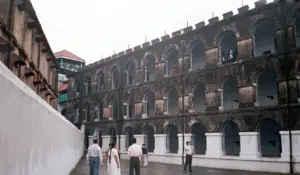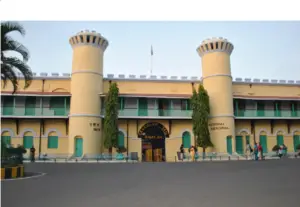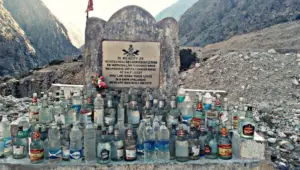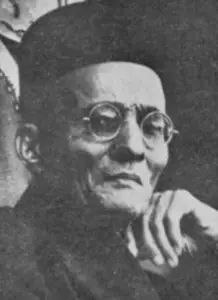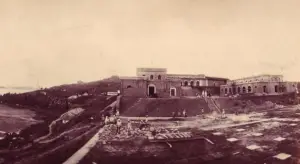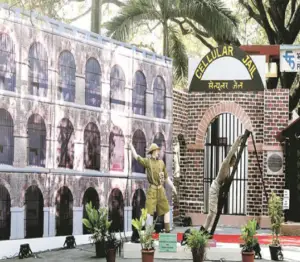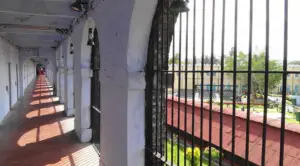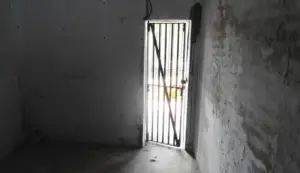Interesting facts about Cellular Jail(kala pani) | Historical Facts

- By
- Aparna Patel
- |
- 1 Sep, 2019
- |
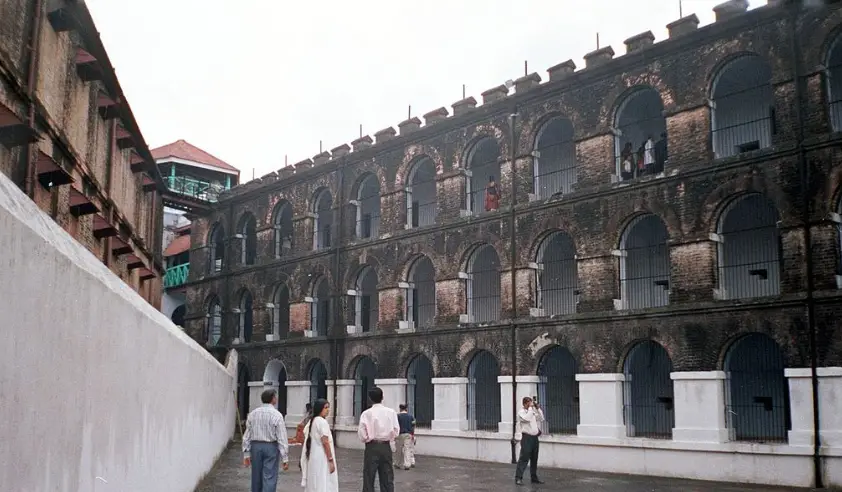
Cellular Jail(kala pani)-
The notorious cellular prison known as Kala Pani remains in Port Blair, the capital of Andaman and Nicobar Islands. The prisoner who used to reach this jail after being punished was called the punishment of black water. The idea of building this prison came to the British mind after the Revolt of 1857. The construction work of this prison with a total of 696 cells started in 1896 and was completed in 1906.
The British had taken every step to give severe torture to the freedom fighters fighting for the independence of India. In this episode, to keep the rebellious people away, from the general public, a prison was created which is outside the whole of India. The British had taken every step to give severe torture to the freedom fighters fighting for the independence of India. In this episode, to keep the rebellious people away from the general public, a prison was created which is outside the whole of India. The name of this jail is Cellular jail. This prison was used by the British to imprison political prisoners on remote islands. Many freedom fighters like Batukeshwar Dutt, Yogeshwar Shukla, and Vinayak Damodar Savarkar were kept in this prison when India was fighting for independence. Presently the premises of the jail has been given the title of National Memorial.
Table of Contents
Amazing Famous Fun Facts About Cellular Jail(kala pani) For Tourists and Kids
- There are many jails in every country in the world that have been created to punish prisoners who commit crimes. Many of them are in such a jail, whose names have left the prisoners’ sweat. One of those black water punishments.
- During the first revolution of 1857, the British planned to build this prison.
- The British had taken every step to give severe hardships to the fighters.
- This prison was built by the British and the purpose of making it was to capture the freedom fighters who participated in the freedom struggle.
- It took 10 years to build this prison.
- There were 696 cells in this 3-floor and 7 branch prison.
- The size of a cell was 4.5 meters to 2.7 meters.
- Let us tell you that inmates were kept in prison in the Cellular Jail, and they were used to carry out various types of work such as oil extraction, rope making, coconut peel etc.. This punishment is extremely creepy for any prisoner.
- Let me tell you that anyone who was heard punishing black water was kept thousands of kilometers away from the land of India. Because even if a prisoner wants to flee from here, he cannot run. That is because jail is surrounded, by water from all four sides.
- Let me tell you that this word still pierces like a sharp arrow in the chest of the people of Punjab, because like other parts of the country before independence, many Punjabis sacrificed their lives for India’s independence in the jail there.
- There was no bedroom in this jail and inside this jail there are 694 rooms.
- There is also a museum where the weapons can be seen from which the freedom fighters were tortured.
- They were not brought here to separate from the society, but they were also employed in the construction of prison, building construction, port construction etc.
- The prisoners who came here also used to build houses of British rulers.
- You will be surprised to know that prisoners were tied to, the mouth of cannons and they were blown up. Many prisoners were tortured and killed.
- The first 200 rebels in this prison were brought here to protect the jailer David Berry and Major James Pattison Walker.
- 733 rebels were brought here from Karachi.
- Its main building is made of red bricks and these bricks were procured from Burma.
- The prisoner of one cell could not have any contact with the prisoner of the other cell.
- Vinayak Damodar Savarkar was sent to jail for ‘Kalapani’ on July 4, 1911.
- A tower was built in the middle of the prison from where prisoners were kept under watch.
- There were also arrangements for weddings in the jail so that the prisoners should be tied up with them.
- The cellular prison was built on a Panopticon model created by British social thinker Jeremy Bentham.
- Only a watchman, could sit in the watchtower in the middle and keep an eye on all the prisoners in the entire jail and the prisoners could not know whether anyone was watching them or not.
- This jail was shaped like octopus.
- Each of the seven arms of the Cellular Jail had three floors. Instead of rooms or dormitories, there were 693 small cells or cells.
- The Savarkar brothers Babarao Savarkar and Veer Vinayak Damodar Savarkar used to live in separate cells of the Cellular Jail, but for two years they did not realize that both were lodged in the same prison.
- The space between the two wings of the Cellular Jail was used to get prisoners to work.
- Prisoners were also used to get soil filled in the marshy ground and to clean the forest, to make roads. If the scheduled work, was not completed on time, the political prisoners, would have to face terrible physical torture and were held in shackles.
- Sound and light show is held every Tuesday, Thursday, Saturday and Sunday at the Cellular Jail Memorial in memory of the martyrs.
Watch Cellular Jail Video Here:
‘Kala Pani’ means life over
Uttarkashi, located in the state of Uttarakhand, India, has a valley named Nelong (110 km) from the district headquarters of Uttarkashi. And there is no population living in this Nelong valley. Because there is a lot of snow here due to which it is not possible to stay here, but there are posts of Indo-Tibetan Border Police and Army here. Due to which the soldiers of the country remain stationed here for 12 months on duty. Even in summer, it is not so difficult to do service here. But due to heavy snowfall here in winter, the soldiers have to face many difficulties. Even the soldiers posted here have to drink water by melting ice and the unique tradition performed here is also related to water.
According to the stories, in 1994, three soldiers of the Army’s 64 Field Regiment, Havildar Jhoom Prasad Gurung, Bahadur and Nayak Surendra Singh were on a walk here. But during the walk the soldiers finished drinking water and to quench their thirst, the soldiers were going 2 kilometers down the Nelong valley where there was a source of water. But on the return, three soldiers were buried in the snow as soon as heavy snow fell and they died. After searching for several days, the army found the bodies of those soldiers in the snow.
Read More:Interesting and fun facts about Amer Fort
The story of the cruelty
At the end of the show, the mood of the freedom fighters, who are awake at the time of independence, the admiration of the tree does help in wiping the audience’s tears.
From hanging cell to Veer Savarkar’s closet
After entering the prison, a closed room finally appears on the right. There is also a door adjacent to it, which opens to the sea outside. When we moved towards it, we came to know that it is a hanging cell. There are two parts below and above it. Three traps at the top and clean floors at the bottom. During the British rule, after being hanged in the upper part, the bodies used to go down as soon as the fret was, removed. Then the dead bodies were taken out of the adjoining gates and drained from the sea through the river. For this reason, they were kept here for 10 consecutive years while other prisoners, were not kept in a cell for more than 30 days. Despite this, he did not break and today in the history of India, his name is written, in the golden letters.
Must read: OMG gateway of india
Construction and Architecture
- The construction of Cellular Jail started in 1896 AD, and it was completely formed, in 1906 AD. It was built, by the British government, the cost of making it was about five lakh seventeen thousand five hundred and thirteen rupees.
- There are 694, cells inside this prison, the cell which, is built in it is called Cell whose size is 4.5 meters × 2.7 meters.
- The purpose of building these cells was to stop the mutual interaction of the prisoners so that they could not come together nor form a strategy.
- Its outer wall is very small, its height is about three meters, which can be jumped out by anyone, but this cellular prison is built, in the sea far away from the land of India and after jumping that wall there is only water around it which no one can cross.
- The names of the brave, martyrs are written on the walls of these prison cells.
- There is also a museum in this prison which has weapons which used to torture the freedom fighters.
- Its main building was constructed, from red bricks brought from Burma in what is now known as Myanmar.
- This jail was named Cellular jail because it was constructed, in the shape of an octopus. The octopus is a marine organism that is 8-legged. Seven sections were built, in this jail and each section of it was of 3 floors.
- A large pillar was, placed between the seven blocks from where all the inmates of the prison, could be seen together and their movements, could be monitored. Above this pillar was a huge bell, which was played, when there was a possible danger.
- In the memory of those who sacrificed their lives for freedom, the unbroken flame is burning in this prison.
- Photographs of freedom fighters displayed in the photo gallery are honoring them. But what we see in the light and sound show held in the jail every evening, proves that we Indians may not be able to pay the price for the freedom that we have endured.
Read also: Do you know these things about India Gate
Kala Pani punishment and atrocities with freedom fighter
When we remember the freedom fighters, then we also cherish the punishment of black water, it is such a punishment which the people of that time used to tremble as soon as they heard the name Kala Pani. However, the punishment of black water (Kala Pani) has no longer existed in the country. This cellular jail came to be known as Kala Pani Jail because this place was thousands of kilometers away from the land of India, this area falls in the Bay of Bengal, the prisoners who were, kept in this, jail were kept separately. The purpose of keeping the British apart was that, if all the prisoners remain separate then they will not be able to make any freedom struggle strategy and if they are lonely, then they will break from the inside and they, will have to accept the government’s point. Inmates in this jail were, tortured a lot, in which every prisoner had to crush 30 pounds of coconut and mustard every day. And the one who could not do this work was beaten very badly and kept in fetters.
Name of some of the big prisoners who have been punished in the Cellular Jail
Dr. Deewan Singh, Yogendra Shukla, Vaman Rao Joshi, Gopal Bhai Parmanand, Batukeshwar Dutt, Vinayak Damodar Savarkar, Baburao Savarkar, Sohan Singh, Maulana Ahmedullah, Mawali Abdul Rahim Sadiqpuri, Maulana Fazal-e-Haq Khairabadi etc.
Which freedom fighters were kept here? How many freedom fighters were there in total? Nobody knows it well till date and what freedom fighter did the painting done on the walls of the Cellular Jail that till date, there is no information about it. After India succeeded independence, two more blocks were destroyed, now only three sections and the tower are left in the middle.
In 1963, Govind Ballabh Pant Hospital opened here, in which 500 beds have been set up for patients, 40 doctors posted here served the residents there. In 1969, three volumes and pillars were declared a national monument.
The centenary year, celebrations of the Cellular Jail were celebrated, on 10 March 2006. In the centenary year celebrations, tributes were paid, to all the freedom fighters who were, punished here.
Now it has also become a kind of tourist place people come from far and wide to see it. They have to pay some money to get inside the jail, to carry the camera, etc. stuff and to take advantage of the facilities.
Read also: You dont know these things about Jaisalmer Fort
Why was black water (kala pani) called?
It was called black water because that prison was located thousands of kilometers away from the mainland of India. In the capital Port Blair, the place where this jail was built was filled with water because the whole area is under the Bay of Bengal. Cellular prison walls, cramped chambers, convey the pain of hundreds of freedom fighters who endured the oppression of the British rule.
Find cellular jail On Google Map
Time for cellular jail and jail museum:
09:00 AM to 12:30 PM, 01:30 to 04:45 (open all days except national holidays)
- Entry Fee (INR): Rs. 30
- Camera: Rs. 200
- Video Camera: Rs. 1000
- Film shooting (prior permission) Rs. 10000 per day
Search Posts
Latest posts
-
4 Mar, 2024
How can I do a "broad" search for flights?
-
4 Mar, 2024
How to make dining alone less awkward?
-
5 Mar, 2024
Why prohibit engine braking?
Popular posts
-
5 Mar, 2024
Why prohibit engine braking?
